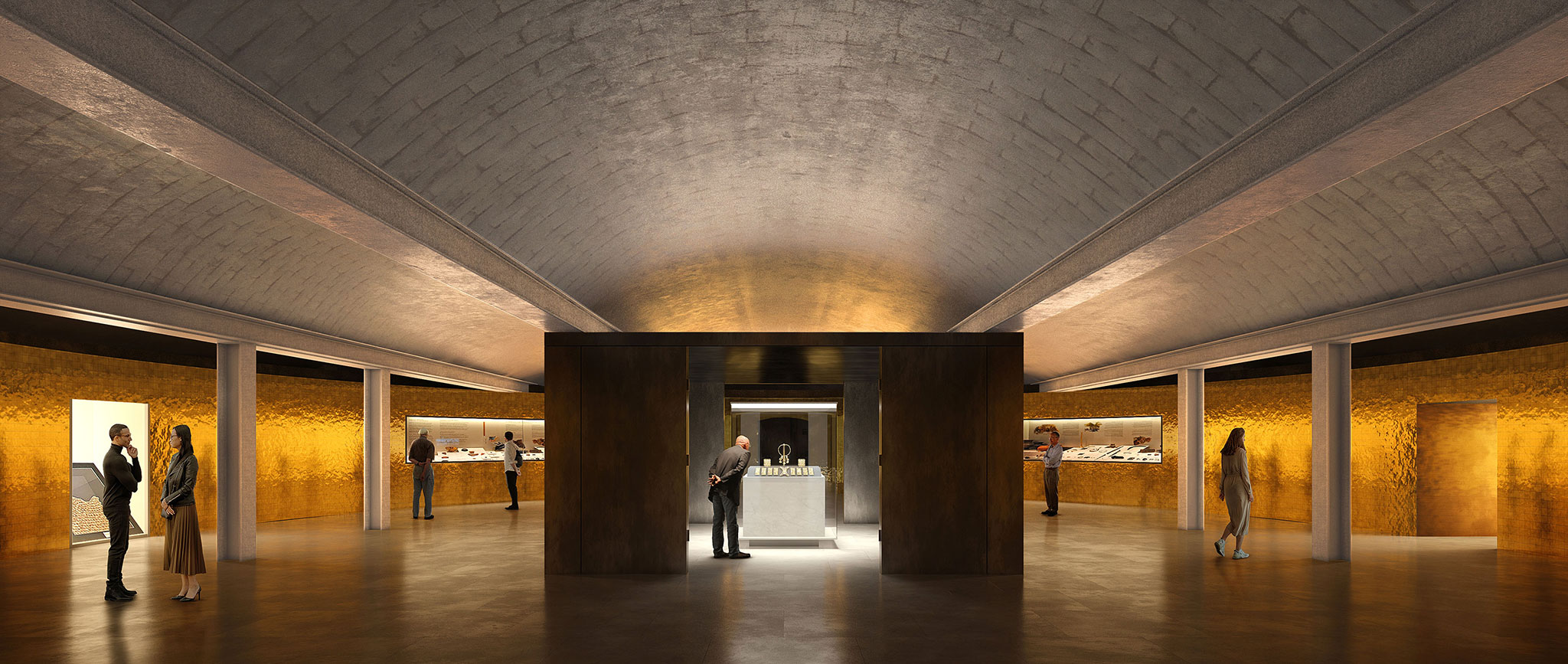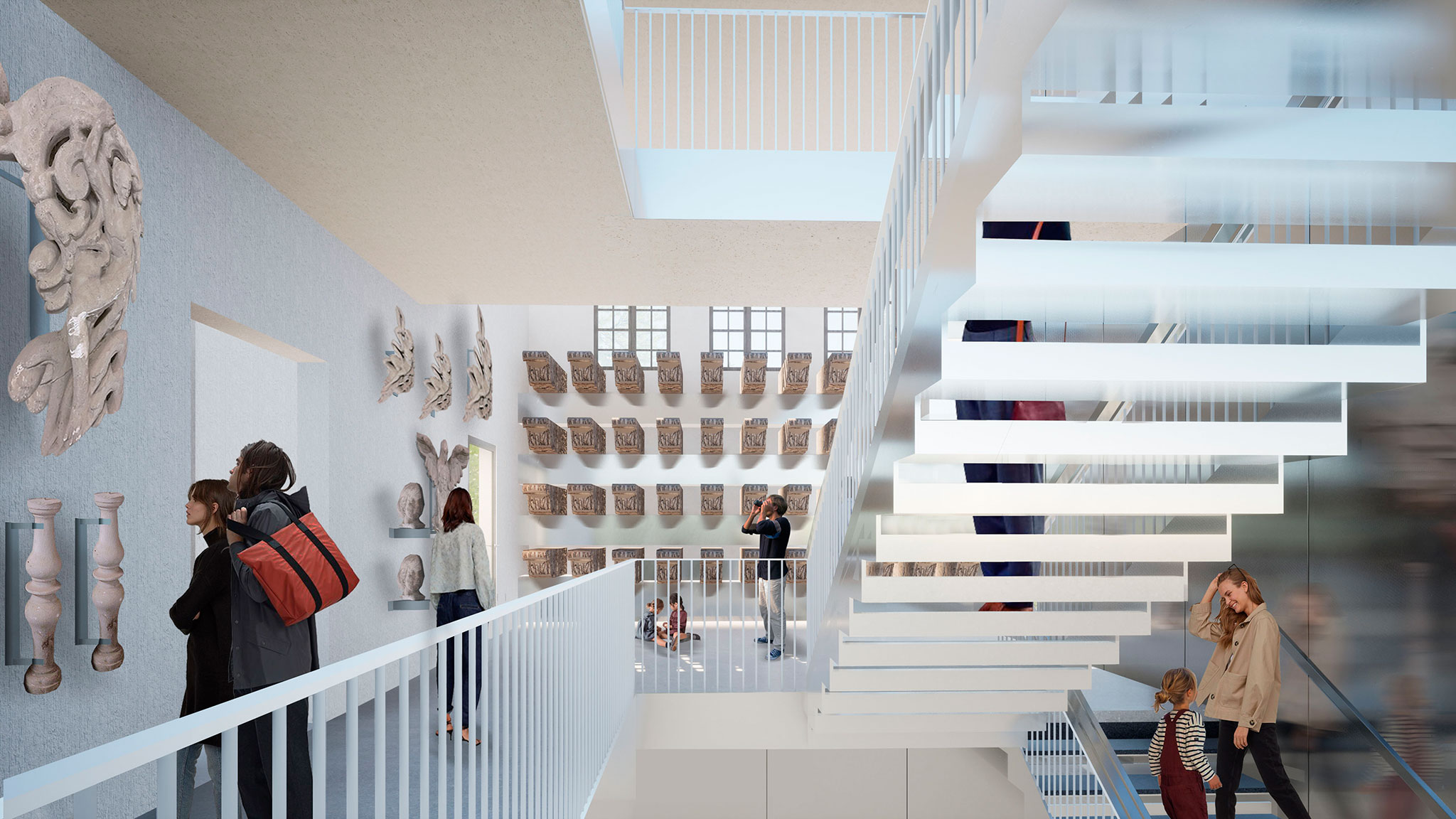The rehabilitation of Vázquez Consuegra will affect the entire building. Building functionality problems will be resolved through restoration, consolidation, conditioning, and removal of inappropriate additions.
The building will open up to the surroundings of the María Luisa Park and the substantive operation of the project is developed on its transversal axis, which would try to rescue the space of the central oval as the museum's main entrance and lobby.
The Oval Room becomes the key element of the compositional and symbolic order of the intervention, adding a new vertical, light and glazed communication nucleus that will allow the three exhibition levels of the museum to be clearly and satisfactorily connected.

Rendering. Renovation of the Archaeological Museum of Seville by Guillermo Vázquez Consuegra.
It will recover its position as a space for admission and reception; access to the different routes, information, rest areas, ticket sales, organization of groups, etc. An idea similar to that of Aníbal González's project for the Ibero-American Exhibition of 1929.
The intervention in the central axis, both horizontally and vertically, takes on meaning as it forms part of the historical process of the building. Therefore, it proposes a new vertical communications core on its rear façade, right on its central axis.
Communication between the north and south façades is also enhanced thanks to the opening of the large door located at the back, now closed, to the new space for communication and vertical circulation, bright and transparent, which overlooks the gardens.
At the upper level, two footbridges will be incorporated where the intervention reaches its highest degree of qualification, curved that oppose their convexity to the concave planes of the oval. Semi-basement will be adapted for the exhibition of prehistoric. material.

Rendering. Renovation of the Archaeological Museum of Seville by Guillermo Vázquez Consuegra.
Description of project by Guillermo Vázquez Consuegra
The current headquarters of the Archaeological Museum of Seville, with a magnificent permanent collection of really superb pieces, is an obsolete and dilapidated container. It is, however, a notable building by the architect Aníbal González built between 1911-1919, with a series of subsequent interventions of unequal success that have gradually devalued, if not nullified, the spatial potential of the original building.
This essential and long-awaited intervention project in the Archaeological Museum represents the opportunity to finally undertake, in a unitary and complete way, an integral intervention that will affect the entire building. A global vision that, while allowing its splendid permanent collection to be adequately displayed, opening the building to the beautiful surroundings of the María Luisa Park and resolving the atavistic functional problems that were never properly resolved, will undertake a series of restoration, consolidation, conditioning and removal of inappropriate additions. Essential operations for the survival of the heritage values of the building, as well as to respond to the contemporary requirements and demands of a museum for the 21st century.
The reforms that have been taking place over the years have led to the progressive alteration of the building typology and the internal spatiality of the Aníbal González building, imposing other logics alien to the original construction, but without fundamentally altering the exterior image of its architecture.

Rendering. Renovation of the Archaeological Museum of Seville by Guillermo Vázquez Consuegra.
The substantive operation of the project is developed on its transversal axis. An operation that would try to rescue the space of the central oval as the entrance and main lobby of the museum, adding a new vertical, light and glazed communication core that will allow the three exhibition levels of the museum to be connected in a clear and satisfactory way.
Intervening in the central axis, both horizontally and vertically, acquires a deep meaning as it is part of the historical process that has resulted, in this overlapping of layers of history, the most beautiful buildings in the history of architecture.
Therefore, a new vertical communications core is proposed on its rear façade, right on its central axis. It is located on the outside of the building but as close to its south façade as functional conditions allow and slightly behind the projection line of the towers, so it will be inscribed inside the virtual envelope of the existing building, or In other words, always within the solid capacity of the building.

Rendering. Renovation of the Archaeological Museum of Seville by Guillermo Vázquez Consuegra.
In the proposal, the Oval Room becomes the key element of the compositional and symbolic order of the intervention, recovering its position as an entrance and reception space (access to the different routes, information, rest areas, ticket sales, organization of groups, etc.) as was the case in Aníbal González's project when it was projected for the Ibero-American Exhibition of 1929.
From this central space, it will be possible to access both the temporary exhibitions and the permanent exhibition of the museum. Communication between the north and south façades is also enhanced thanks to the opening of the large door located at the back (today closed) to the new space for communication and vertical circulation, bright and transparent, which overlooks the gardens. Therefore, a greater permeability and visual opening of the building towards its surroundings is achieved, now intensified with the opening of the external loggias. Permeability, transparency and natural light.
The proposal proposes the substitution of the existing skylight for another element of solar control design more in line with the geometry of the Oval Room, placing it just at the level of the original skylight and therefore recovering its original height as well as the global perception of its interior. , thus enhancing the vertical spatiality of the new great hall of the museum.

Rendering. Renovation of the Archaeological Museum of Seville by Guillermo Vázquez Consuegra.
But it will have to be at the higher level with the incorporation of two catwalks, where the intervention reaches its highest degree of qualification. Two curved walkways that oppose their convexity to the concave planes of the oval, in a subtle adjustment of curves and counter curves, will constitute the starting point of the new geometric layout of the suspended solar control element, with sufficient thickness to avoid direct sunlight, while time that add a contemporary component to the historical, constructive and museographic stratigraphy of the museum.
The different and fragmented interventions that have taken place, from the first reforms of 1942 and 1946 to the most profound of 1971-1973 or the most recent of 1981 or 2007-2015, with very different regulatory requirements from the current ones, make it necessary to carry out a structural reorganization which will substantially affect the upper floor slabs, trying, in any case, to maintain those that could be recoverable.
In the semi-basement, a floor that was designed as a sanitary floor to insulate and protect the ground floor from humidity, the level of its pavement has been slightly lowered, making the resulting spaces suitable for the exhibition of prehistoric material, which is currently shows at this level, undoubtedly now qualified by the intervention not only architectural but also museographic. All these vaulted enclosures culminate in the oval enclosure for the Treasure Room, where the Carambolo Treasure will be displayed, a stellar piece of the Museum's collection. Finally, different operations in the topography of the land, and taking care not to affect the leafy trees near the building on its rear façade, will facilitate vehicle and pedestrian access to the different rooms that make up this floor and that you will enjoy, Now yes, natural lighting and ventilation.









































